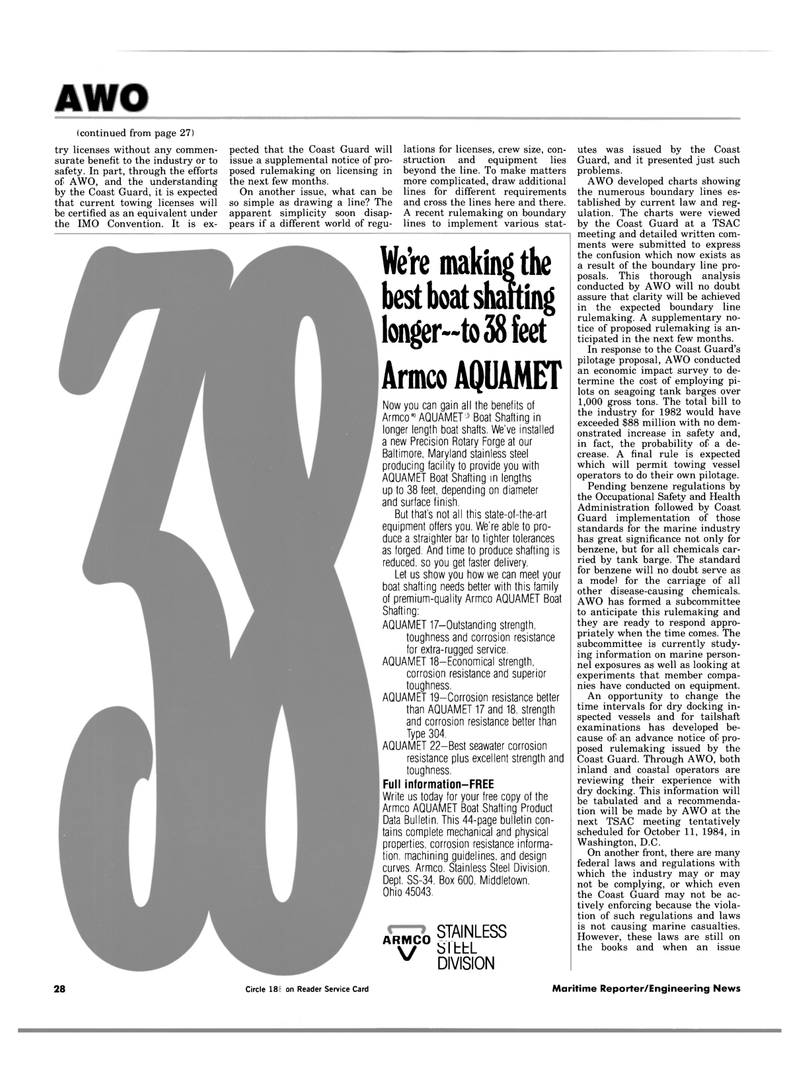
Page 26: of Maritime Reporter Magazine (August 1984)
Read this page in Pdf, Flash or Html5 edition of August 1984 Maritime Reporter Magazine
AWO (continued from page 27) try licenses without any commen- surate benefit to the industry or to safety. In part, through the efforts of AWO, and the understanding by the Coast Guard, it is expected that current towing licenses will be certified as an equivalent under the IMO Convention. It is ex- pected that the Coast Guard will issue a supplemental notice of pro- posed rulemaking on licensing in the next few months.
On another issue, what can be so simple as drawing a line? The apparent simplicity soon disap- pears if a different world of regu- lations for licenses, crew size, con- struction and equipment lies beyond the line. To make matters more complicated, draw additional lines for different requirements and cross the lines here and there.
A recent rulemaking on boundary lines to implement various stat- utes was issued by the Coast
Guard, and it presented just such problems.
AWO developed charts showing the numerous boundary lines es- tablished by current law and reg- ulation. The charts were viewed by the Coast Guard at a TSAC meeting and detailed written com- ments were submitted to express the confusion which now exists as a result of the boundary line pro- posals. This thorough analysis conducted by AWO will no doubt assure that clarity will be achieved in the expected boundary line rulemaking. A supplementary no- tice of proposed rulemaking is an- ticipated in the next few months.
In response to the Coast Guard's pilotage proposal, AWO conducted an economic impact survey to de- termine the cost of employing pi- lots on seagoing tank barges over 1,000 gross tons. The total bill to the industry for 1982 would have exceeded $88 million with no dem- onstrated increase in safety and, in fact, the probability of a de- crease. A final rule is expected which will permit towing vessel operators to do their own pilotage.
Pending benzene regulations by the Occupational Safety and Health
Administration followed by Coast
Guard implementation of those standards for the marine industry has great significance not only for benzene, but for all chemicals car- ried by tank barge. The standard for benzene will no doubt serve as a mode) for the carriage of all other disease-causing chemicals.
AWO has formed a subcommittee to anticipate this rulemaking and they are ready to respond appro- priately when the time comes. The subcommittee is currently study- ing information on marine person- nel exposures as well as looking at experiments that member compa- nies have conducted on equipment.
An opportunity to change the time intervals for dry docking in- spected vessels and for tailshaft examinations has developed be- cause of an advance notice of pro- posed rulemaking issued by the
Coast Guard. Through AWO, both inland and coastal operators are reviewing their experience with dry docking. This information will be tabulated and a recommenda- tion will be made by AWO at the next TSAC meeting tentatively scheduled for October 11, 1984, in
Washington, D.C.
On another front, there are many federal laws and regulations with which the industry may or may not be complying, or which even the Coast Guard may not be ac- tively enforcing because the viola- tion of such regulations and laws is not causing marine casualties.
However, these laws are still on the books and when an issue
We're making the best boat shafting longer—to 38 feet
Armco AQUAMET
Now you can gain all the benefits of
ArmcoR AQUAMET- Boat Shafting in longer length boat shafts. We've installed a new Precision Rotary Forge at our
Baltimore, Maryland stainless steel producing facility to provide you with
AQUAMET Boat Shafting in lengths up to 38 feet, depending on diameter and surface finish.
But that's not all this state-of-the-art eguipment offers you. We're able to pro- duce a straighter bar to tighter tolerances as forged. And time to produce shafting is reduced, so you get faster delivery.
Let us show you how we can meet your boat shafting needs better with this family of premium-quality Armco AQUAMET Boat
Shafting:
AQUAMET 17—Outstanding strength, toughness and corrosion resistance for extra-rugged service.
AQUAMET 18—Economical strength, corrosion resistance and superior toughness.
AQUAMET 19—Corrosion resistance better than AQUAMET 17 and 18, strength and corrosion resistance better than
Type 304.
AQUAMET 22—Best seawater corrosion resistance plus excellent strength and toughness.
Full information-FREE
Write us today for your free copy of the
Armco AQUAMET Boat Shafting Product
Data Bulletin. This 44-page bulletin con- tains complete mechanical and physical properties, corrosion resistance informa- tion. machining guidelines, and design curves. Armco. Stainless Steel Division.
Dept. SS-34, Box 600, Middletown,
Ohio 45043.
ARMCO STAINLESS v/ blttL v DIVISION 28 Circle 118 on Reader Service Card Maritime Reporter/Engineering News

 25
25

 27
27
